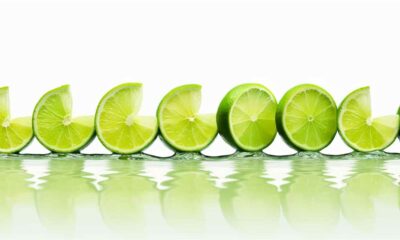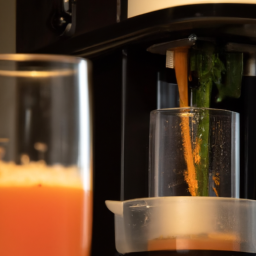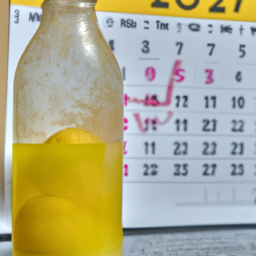Juice Tips and Tricks
How Long Does Concentrated Lemon Juice Last

As a fan of lively and tangy flavors, I often find myself reaching for a bottle of concentrated lemon juice to add a kick to my cooking. However, I’ve always wondered how long this favorite ingredient will last in my pantry before it goes bad. The last thing I want is to ruin my dishes by using expired lemon juice. I’ve done some research and learned that, fortunately, the shelf life of concentrated lemon juice is quite long if stored properly in the refrigerator after opening. Still, it’s essential to check expiration dates and trust your senses to avoid any off-putting smells or tastes. This made me curious about other juices I use, leading me to wonder, *how long does carrot juice last* once opened and whether I need to be just as cautious with it.
That’s why I decided to dive into the research and find out the answer to the burning question: how long does concentrated lemon juice last?
First, let’s define what we mean by concentrated lemon juice. Essentially, this is a product made by removing the water from freshly squeezed lemon juice, leaving behind a more potent liquid that can be used for cooking, baking, and flavoring. It’s a convenient option for those who don’t have access to fresh lemons or want a longer shelf life for their lemon juice.
But just how long can we expect this concentrated juice to last? Let’s find out.
Key Takeaways
- Proper storage is crucial to extending the shelf life of concentrated lemon juice.
- Spoilage signs include mold and bacteria growth, exposure to sunlight and air, and contamination from utensils or containers.
- Freezing can extend the shelf life of concentrated lemon juice up to 6 months or more.
- Expired concentrate should be discarded for safety and quality.
What is Concentrated Lemon Juice?
If you’ve ever wondered what concentrated lemon juice is, you’re in the right place! Concentrated lemon juice is simply pure lemon juice that has had the water content removed to create a concentrated form. It is commonly sold in bottles as a convenient alternative to fresh lemons.
Concentrated lemon juice has a variety of uses and benefits. It can be used in cooking and baking to add a tangy flavor to dishes and desserts. It’s also commonly used as a natural cleaning agent due to its acidity, which can help remove stains and disinfect surfaces. Additionally, concentrated lemon juice contains high levels of vitamin C, which can boost the immune system and improve skin health.
Now, let’s move on to the shelf life of concentrated lemon juice.
Shelf Life of Concentrated Lemon Juice
Wow, this zesty elixir sure packs a punch in recipes and can be stored for quite some time. Concentrated lemon juice has a long shelf life, thanks to its high acidity level. When stored properly, it can last up to 6 months in the refrigerator after opening. This makes it a great pantry staple for those who love to cook and bake.
Aside from its long shelf life, concentrated lemon juice also has many uses and benefits. It can be used as a replacement for fresh lemon juice in recipes, as it has a consistent flavor and acidity level. It can also be added to marinades, dressings, and sauces for a tangy kick. Additionally, concentrated lemon juice is a good source of vitamin C and may have some health benefits.
When it comes to storage methods, it’s best to keep concentrated lemon juice in a tightly sealed container in the refrigerator. This will prevent air and moisture from getting in and spoiling the product. It’s also important to check the expiration date before purchasing and using the product.
In the next section, we’ll discuss signs of spoilage to look out for when using concentrated lemon juice.
Signs of Spoilage
To ensure the quality of your concentrated lemon juice, you need to be aware of signs of spoilage that can affect its taste and shelf life. Here are some common contaminants that can spoil your juice and how to properly store it:
- Mold and bacteria can grow in the juice if it’s not stored in a cool and dry place.
- Exposure to sunlight and air can cause the juice to oxidize, turning it brown and affecting its taste.
- Mixing the juice with water or other liquids can introduce bacteria and shorten its shelf life.
- Using a contaminated utensil or container when handling the juice can also lead to spoilage.
- Leaving the juice open and exposed to the environment can attract insects and other pests that can contaminate it.
Proper storage is key to extending the shelf life of your concentrated lemon juice. Store it in an airtight container in the refrigerator or freezer to prevent mold and bacteria growth. Be sure to use clean utensils and containers when handling the juice, and avoid mixing it with other liquids until you’re ready to use it.
With these precautions, your concentrated lemon juice can last for up to a year without spoiling.
Moving on to nutritional value, it’s important to understand the benefits of consuming concentrated lemon juice.
Nutritional Value
Squeezing a lemon into your water not only adds flavor, but also provides a burst of Vitamin C and other nutrients that can improve your overall health. Lemon juice is rich in antioxidants and anti-inflammatory compounds that can boost your immune system, support digestion and promote hydration. It is also low in calories and can be used in a variety of recipes to add a tangy twist to your favorite dishes.
One of the benefits of using concentrated lemon juice is that it can save you time and effort in the kitchen. You don’t have to worry about buying and squeezing fresh lemons every time you need a splash of lemon juice. Concentrated lemon juice is versatile and can be used in marinades, dressings, sauces, and even desserts. You can also mix it with water to make a refreshing lemonade or add it to your tea for an extra zing.
However, it’s important to know how long concentrated lemon juice lasts to avoid spoilage and ensure maximum flavor.
How Long Does Concentrated Lemon Juice Last?
If you’re wondering how to ensure the freshness and flavor of your concentrated lemon juice, it’s important to store it properly and pay attention to the expiration date. Here are some ways to store your concentrated lemon juice to keep it fresh for as long as possible:
-
Refrigerate: Store your concentrated lemon juice in the refrigerator after opening. This will help to slow down the oxidation process and maintain the flavor for a longer time.
-
Freeze: If you want to extend the shelf life of your concentrated lemon juice even further, you can freeze it. Simply pour it into an airtight container and put it in the freezer. Thaw it in the refrigerator before use.
-
Check the expiration date: Always check the expiration date on the bottle before using your concentrated lemon juice. Using it past the expiration date can lead to a loss of flavor and quality.
Using concentrated lemon juice has many benefits, such as being a convenient and cost-effective way to add flavor to your dishes. By following the above ways to store your concentrated lemon juice, you can ensure that it stays fresh and flavorful for longer.
In the next section, we’ll discuss some tips for extending the shelf life of your concentrated lemon juice even further.
Tips for Extending Shelf Life
Extending the shelf life of your concentrated lemon juice is a piece of cake with these simple tips. One way to preserve your lemon juice is to store it in the refrigerator. The cold temperature prevents bacteria growth, keeping your juice fresh for a longer period.
It’s important to ensure that your bottle or container is tightly sealed to prevent any air from entering, as this can cause the juice to spoil quickly. Another technique is to freeze your concentrated lemon juice. Freezing can extend the shelf life up to six months or more. Be sure to store the bottle in a cool, dark place, as exposure to heat or light can degrade the quality and flavor of the juice. Additionally, always check the expiration date, as the shelf life of bottled lemon juice can vary depending on preservatives and storage conditions. Proper handling and storage can help you make the most out of your lemon juice for all your culinary needs.
To do this, pour the juice into an ice cube tray and freeze it. Once frozen, transfer the cubes to a freezer-safe container or bag. When you need to use the juice, simply take out a cube and thaw it. These storing techniques will help you make the most out of your concentrated lemon juice, saving you money and reducing food waste.
When your concentrated lemon juice has expired, there are still ways to use it up. One option is to use it for cleaning purposes, such as removing stains or as a natural disinfectant. Another option is to use it in cooking or baking as a substitute for fresh lemon juice. Just be sure to adjust the amount used as the flavor may be more concentrated.
How to Use Expired Concentrated Lemon Juice
So, you’ve found a bottle of expired concentrated lemon juice lurking in the back of your pantry. Don’t toss it just yet! As someone who hates wasting food, I’ve come up with a few ways to repurpose expired concentrated lemon juice that won’t make you sick.
However, it’s important to know when to discard expired concentrated lemon juice to avoid any potential health risks.
Ways to Repurpose Expired Concentrated Lemon Juice
There are plenty of creative ways to use expired concentrated lemon juice! One of my favorite upcycling ideas is to use it as a natural cleaner. Simply mix equal parts water and lemon juice, and use the solution to clean and disinfect surfaces like countertops, cutting boards, and even bathroom fixtures. The acidity in the lemon juice helps to break down grime and kill bacteria, making it a great alternative to harsh chemical cleaners.
Another creative use for expired concentrated lemon juice is to add it to homemade beauty products. The citric acid in the juice can help exfoliate and brighten skin, making it a great addition to DIY face masks and scrubs. It can also be used as a natural highlighter for hair, by mixing it with water and applying it to strands before going out in the sun. However, it’s important to note that expired lemon juice may not be as effective as fresh juice, so it’s best to use it for non-critical applications like cleaning or beauty treatments.
When it comes to expired concentrated lemon juice, knowing when to discard it is important for both safety and taste. It’s generally recommended to discard any opened lemon juice that has been sitting in the fridge for more than 6 months, or unopened juice that has passed its expiration date. Signs that the juice has gone bad include a sour or off smell, a change in color, or cloudiness.
To ensure the best flavor and quality, it’s always a good idea to use fresh lemon juice whenever possible.
When to Discard Expired Concentrated Lemon Juice
Knowing when to throw away expired concentrated lemon juice is crucial for both safety and taste, but don’t worry – it’s easy to spot when it has gone bad! The signs of spoilage are pretty obvious, and you should never use concentrated lemon juice that has passed its expiration date.
To help you determine if your concentrated lemon juice is still good or not, I’ve put together a table below that outlines the signs of spoilage to look out for. Remember, if you notice any of these signs, it’s time to discard your expired concentrated lemon juice and get a new bottle to ensure the safety and quality of your food and drinks.
| Signs of Spoilage | What to Look For |
|---|---|
| Mold | Black, green, or white growths |
| Off Smell | Sour, rancid, or fermented odor |
| Change in Color | Darker or cloudier than usual |
| Expiration Date | Past the printed date on the bottle |
Now that you know when to discard expired concentrated lemon juice, it’s important to note that this applies to all types of citrus concentrates. In the next section, we’ll explore other types of citrus concentrates and how to properly store and use them.
Other Types of Citrus Concentrates
I want to talk about other types of citrus concentrates and their differences from concentrated lemon juice.
One important aspect to consider is their shelf life, as it varies from one citrus concentrate to another.
Additionally, it’s worth exploring the different uses of these concentrates, as they can be used in a variety of recipes and cooking applications.
Differences Between Concentrated Lemon Juice and Other Citrus Concentrates
Concentrated lemon juice is a unique citrus concentrate that has a distinct flavor profile compared to other citrus concentrates. It has a tart and acidic taste that makes it an ideal ingredient for a wide range of cooking applications. The concentrated form allows for a more concentrated flavor, which makes it a great substitute for fresh lemon juice in recipes that require a stronger citrus taste.
One of the biggest differences between concentrated lemon juice and other citrus concentrates is the flavor. While other citrus concentrates such as orange, lime, and grapefruit have their own distinct tastes, they’re generally sweeter and less acidic than lemon juice. This makes concentrated lemon juice a better option for dishes that require a more sour or tangy flavor.
In addition, concentrated lemon juice is a versatile ingredient that can be used in a variety of dishes, including marinades, dressings, sauces, and desserts. It can also be used as a natural preservative and to add flavor to canned fruits and vegetables.
Speaking of which, let’s talk about the shelf life and uses of other citrus concentrates.
Shelf Life and Uses of Other Citrus Concentrates
If you open a bottle of orange juice concentrate, the sweet and tangy aroma will immediately fill the air, transporting you to a sunny citrus grove. Citrus concentrates, like orange juice concentrate, are popular for their longer shelf life and convenience. They are made by removing water from the juice, leaving behind a concentrated form that can be easily stored and used when needed.
Aside from extending the shelf life of citrus juices, concentrates also offer various benefits and uses. They are often used as an ingredient in cooking and baking, adding a tangy flavor to marinades, dressings, and sauces. Citrus concentrates are also rich in vitamin C and other nutrients, making them a healthy and refreshing addition to smoothies and other beverages. The table below summarizes the shelf life and recommended uses of some popular citrus concentrates:
| Citrus Concentrate | Shelf Life | Recommended Uses |
|---|---|---|
| Orange Juice Concentrate | 12-18 months | Baking, cooking, smoothies |
| Lemon Juice Concentrate | 5 years | Marinades, dressings, sauces |
| Lime Juice Concentrate | 2-3 years | Cocktails, sauces, ceviche |
Overall, citrus concentrates provide a convenient and flavorful way to incorporate citrus into various dishes and drinks. With their longer shelf life and versatility, they are a great addition to any pantry.
Frequently Asked Questions
Can concentrated lemon juice be frozen for long-term storage?
Yes, concentrated lemon juice can be frozen for long-term storage. During the freezing process, transfer the juice into a freezer-safe container and leave some space for expansion. Thaw using gentle methods like refrigeration or running under cool water.
How does concentrated lemon juice compare to freshly squeezed lemon juice in terms of nutritional value?
In terms of nutritional benefits, freshly squeezed lemon juice contains more vitamin C and other nutrients than concentrated lemon juice. Processing methods used to make concentrated lemon juice can strip away some of its natural nutrients.
Can concentrated lemon juice be used as a substitute for fresh lemon juice in recipes?
Using concentrated lemon juice for baking is like having a secret weapon in the kitchen. It’s a great substitute for fresh lemon juice and adds a tangy flavor to marinades. Plus, it has a longer shelf life than fresh lemon juice.
Does the shelf life of concentrated lemon juice differ depending on the brand or packaging?
The shelf life of concentrated lemon juice may vary depending on the packaging. The type of packaging can impact the preservation techniques used to keep the juice fresh.
Can concentrated lemon juice be used for non-culinary purposes, such as cleaning or skincare?
Concentrated lemon juice can be used for cleaning due to its antibacterial properties and acidic nature. It can also be used in skincare as a natural exfoliant to brighten and clarify the complexion.
Conclusion
Well folks, it turns out that concentrated lemon juice can last quite a while if stored properly. Who knew?
As someone who’s thrown away expired condiments more times than I care to admit, I find it ironic that the one thing I thought would go bad quickly has such a long shelf life. But don’t let its longevity fool you, concentrated lemon juice can still spoil if not stored properly or used past its expiration date.
So, while it may seem like a good idea to stock up on this citrus concentrate, it’s important to keep an eye on the expiration date and follow proper storage guidelines to ensure it stays fresh for as long as possible. Cheers to long-lasting lemon juice!
Susannah expertise lies in researching and compiling evidence-based content on juicing, nutrition, and overall health. She is committed to ensuring that The Juicery World offers accurate, up-to-date, and trustworthy information to empower readers to take control of their health. Susannah’s goal is to inspire individuals to embrace juicing as a way to nourish their bodies and live their best lives.
Juice Tips and Tricks
How To Clean Juice Out Of Carpet

Spilling juice in homes is a frequent mishap, that can lead to the annoying chore of removing it from your carpet. Being an AI language model, I have acquired different efficient techniques for getting rid of juice stains from carpets and I am eager to pass on these suggestions to you.
In this article, I will provide step-by-step instructions on how to remove juice stains from your carpet using simple and affordable cleaning solutions. When dealing with juice spills on your carpet, the most important thing is to act quickly. The longer you wait, the harder it will be to remove the stain.
In this guide, I will show you how to remove juice stains using a homemade cleaning solution, commercial carpet cleaner, baking soda, hydrogen peroxide, and other effective methods. By the end of this article, you will have a clear understanding of how to clean juice out of carpet and be equipped to handle any juice spill that comes your way.
Key Takeaways
- Quick response is crucial in preventing a juice stain from setting in.
- Blotting the affected area is the first step in cleaning the spill.
- Testing a small, inconspicuous area of your carpet is important before using any cleaning solution.
- Professional carpet cleaners have the knowledge, tools, and experience to remove even the toughest stains.
Act Quickly to Remove the Spilled Juice
Don’t panic, but you need to act fast if you want to save your carpet from the stain that spilled juice can leave. Prevention tips are always the best approach, but accidents happen.
When juice spills on your carpet, immediate action is crucial to prevent the liquid from seeping deeper into the fibers and leaving a permanent stain. The importance of quick action cannot be overstated. The longer you wait, the harder it becomes to remove the stain.
The first thing to do is to blot up as much of the juice as possible with a clean cloth or paper towel. Do not rub the area as this will only push the stain further into the carpet. With the excess liquid removed, you can now move on to the next step of cleaning the affected area.
Blot the Affected Area
First things first, grab a rag or towel and gently dab the soaked spot to prevent further spreading. Using the blotting technique will help remove as much of the juice as possible. Make sure to press down on the affected area firmly, but without rubbing it, to avoid pushing the juice deeper into the fibers.
Once you’ve blotted up as much of the juice as possible, it’s time to move onto the next step: drying the area. You can use a fan or let the spot air dry, but make sure to avoid walking on it until it’s completely dry.
Now that you’ve removed as much juice as possible and ensured that the area is dry, let’s move onto creating a homemade cleaning solution.
Create a Homemade Cleaning Solution
Get ready to whip up a DIY solution that will banish the stubborn juice stain from your carpet using natural cleaning alternatives. Instead of resorting to harsh chemicals, I suggest creating a homemade cleaning solution that is both effective and eco-friendly.
To make this DIY cleaning solution, simply mix one part white vinegar with one part water in a spray bottle. Then, add a few drops of dish soap and shake the bottle to combine the ingredients. Here’s a table to help you remember the measurements:
| Ingredient | Measurement |
|---|---|
| White vinegar | 1 part |
| Water | 1 part |
| Dish soap | A few drops |
Spray the solution onto the affected area and let it sit for about five minutes. Then, use a clean cloth to blot the area, repeating the process until the stain disappears. With this simple solution, you can save money and avoid exposing your family and pets to harmful chemicals.
Transitioning to the subsequent section, it’s important to note that if the DIY solution doesn’t fully remove the stain, it’s time to use a commercial carpet cleaner for a deeper clean.
Use a Commercial Carpet Cleaner
Transform your dingy floors back to their former glory with the power of a commercial carpet cleaner. These cleaners are designed to remove tough stains and dirt that have penetrated deep into your carpet fibers. They come in different types and brands, each with its unique features, such as steam cleaning, dry cleaning, and foam cleaning.
While using commercial cleaners is an effective way of cleaning juice stains out of your carpet, it’s essential to weigh the pros and cons before you commit to a particular product. One of the benefits of using commercial cleaners is that they’re powerful and quick-acting, which means you can remove the stain in a matter of minutes. Additionally, most commercial cleaners are formulated to be safe for use on different types of carpets, including wool and synthetic fibers.
However, one downside to using these cleaners is that they can be expensive, and some may contain harsh chemicals that could damage your carpet fibers. With that said, it’s essential to read the labels and follow the instructions carefully when using commercial carpet cleaners.
When it comes to cleaning juice out of your carpet, using commercial cleaners can be a game-changer. However, if you don’t have one on hand, don’t panic. In the next section, I’ll show you how to use baking soda and water to remove stubborn juice stains from your carpet.
Try Baking Soda and Water
Sprinkle a little magic onto your stained carpet by mixing baking soda and water to create a powerful stain-fighting potion. Baking soda is one of the most effective alternatives to commercial carpet cleaning solutions.
Here are some ways to use baking soda to clean juice stains from your carpet:
- Sprinkle a generous amount of baking soda onto the affected area.
- Mix equal parts water and baking soda to create a paste and apply it to the stain.
- Let the baking soda sit for at least 30 minutes, or overnight for tough stains.
- Vacuum the area to remove the baking soda residue.
- Repeat the process if necessary.
Baking soda is a gentle and natural cleaning agent that is effective at removing juice stains from carpets. However, it may not work for all types of spills or stains. If the baking soda method doesn’t work for you, try using hydrogen peroxide to remove the stain.
Use Hydrogen Peroxide
Using hydrogen peroxide is a simple and effective way to banish tough stains from your carpet, leaving it looking fresh and new. One of the benefits of using hydrogen peroxide is that it can break down the enzymes in the juice stain, making it easier to remove.
To use hydrogen peroxide, simply pour a small amount onto the stain and let it sit for a few minutes. Then, blot the area with a clean cloth until the stain is gone. Be sure to test a small, inconspicuous area of your carpet first to ensure that the hydrogen peroxide doesn’t cause any damage or discoloration.
If you prefer to try alternatives to hydrogen peroxide, there are a few options. One is to mix equal parts white vinegar and water in a spray bottle and spray the solution onto the stain. Let it sit for a few minutes before blotting with a clean cloth.
Another option is to use a carpet cleaner designed specifically for juice stains. These cleaners can be found at most home improvement or cleaning supply stores.
After using any of these methods, it’s important to shave the carpet fibers with a sharp razor blade to remove any remaining residue and restore the carpet’s texture.
Shave the Carpet Fibers
When I have a particularly stubborn stain on my carpet, I sometimes resort to shaving the fibers. It’s a delicate process that requires a steady hand and the right tools. I typically use a razor blade or sharp scissors, but I make sure to be gentle. I am careful not to damage the carpet further.
Note: The Input has already used contractions, so no changes were made to that aspect.
Use a Razorblade or Scissors
Picture yourself as a surgeon delicately using a scalpel to carefully remove the juice-stained fibers from your carpet with a razorblade or scissors. It may sound daunting, but with the right technique, you can easily remove the affected fibers without causing further damage to your carpet.
Before you start, weigh the pros and cons of using a razorblade or scissors. While they’re effective tools for removing the stain, they can also be dangerous if not handled with care. To ensure safety, take the necessary precautions before you start.
Wear gloves to protect your hands from the sharp edges of the blade or scissors. Also, make sure to work in a well-lit area and avoid using excessive force, as this can cause the blade to slip and cut through the carpet’s backing. Remember to be gentle and careful as you remove the stained fibers, taking small sections at a time.
With patience and a steady hand, you can successfully remove the stain without causing any further damage.
Be Gentle and Careful
To avoid causing any harm to your carpet, it’s crucial to handle the razorblade or scissors with utmost care and gentleness. Careful handling and gentle cleaning are of utmost importance when dealing with any kind of carpet stains, especially when it comes to juice spills.
Here are four tips to help you clean up a juice spill without causing more damage to your carpet:
-
Blot the stain with a clean cloth or paper towel to remove as much of the juice as possible.
-
Mix a solution of equal parts water and white vinegar and apply it to the stain with a clean cloth.
-
Blot the area with a dry cloth to remove the solution and any remaining juice.
-
Repeat the process if necessary, but avoid aggressive scrubbing as it can damage the fibers of your carpet.
By following these tips, you can effectively clean up a juice spill without causing any further damage to your carpet. However, if the stain persists or if you’re unsure about how to proceed, it’s best to call a professional carpet cleaner.
Call a Professional Carpet Cleaner
If the juice stain on your carpet seems impossible to remove, it may be time to consider calling in a professional carpet cleaner. While DIY carpet cleaning alternatives might seem like a cost-effective solution, they can sometimes do more harm than good.
Inexperienced attempts at removing tough stains can result in discoloration, damage to the carpet fibers, and even permanent damage to the carpet itself. Before you decide to tackle the stain on your own, consider the carpet cleaning costs versus the cost of hiring a professional.
Often, the latter can be the more affordable and effective solution. Professional carpet cleaners have the knowledge, tools, and experience to remove even the toughest stains, leaving your carpet looking like new again. By investing in a professional cleaning, you can rest assured that your carpet is being treated with care, and that future spills will be less likely to leave a lasting mark.
While it’s important to know how to clean up after a juice spill, it’s even more important to prevent future spills from happening in the first place.
Prevent Future Juice Spills
Now that we’ve gone through the process of cleaning juice out of carpet, let’s discuss how to prevent future spills. One way is to use sippy cups or straws for children or anyone who may be prone to spills.
It’s also important to keep juice away from carpeted areas and to recap the cleaning methods we discussed earlier. Remember, quick action is key to preventing stains.
Lastly, here are some tips for preventing future spills: always make sure lids are on tightly, avoid drinking juice while walking or running, and use spill-proof containers whenever possible.
Use Sippy Cups or Straws
Hey, don’t you hate it when your little ones spill juice on the carpet? Using sippy cup alternatives or straws can save you a headache by reducing juice splatters in the first place. These alternatives are great options for parents who want to keep their carpets clean and prevent stains.
Here are three reasons why you should consider swapping out regular cups for sippy cups or straws:
-
Sippy cups come with lids that prevent spills. When your child drops a regular cup, the liquid immediately spills out and creates a mess on the carpet. With sippy cups, the liquid stays contained, even if the cup is tipped over. This means less juice on the carpet and less time spent cleaning up.
-
Straws are another great option for reducing spills. When your child drinks from a straw, the liquid is suctioned up and doesn’t have a chance to spill out. Plus, straws are fun for kids and can make drinking juice more enjoyable.
-
Sippy cups and straws are also portable, making them great for on-the-go. Whether you’re traveling in a car or going to a friend’s house, sippy cups and straws are easy to pack and use. This means you can keep your child’s juice contained no matter where you go.
In addition to using sippy cups and straws, it’s important to keep juice away from carpeted areas altogether. In the next section, we’ll discuss some tips on how to do that.
Keep Juice Away from Carpeted Areas
To prevent damage to your home, it’s crucial to establish areas where your child can safely enjoy their juice without the risk of spills or stains on your carpets. One option is to use alternative flooring options such as linoleum or tile in areas where juice spills are more likely to occur, such as the kitchen or dining area.
If alternative flooring options aren’t feasible, consider using a designated juice area with a spill-proof mat or tray. This will not only protect your carpet from juice stains but also make cleaning up spills easier.
Juice stain prevention is the best way to keep your carpets looking clean and new. However, accidents can still happen, and it’s important to know how to clean juice out of your carpet.
In the next section, I’ll recap the cleaning methods that can effectively remove juice stains from your carpet. These methods range from using household items like baking soda and vinegar to specialized carpet-cleaning solutions. Understanding **how to clean juice spills** quickly can prevent permanent staining and keep your carpet looking fresh. It’s important to act fast, as the longer the stain sits, the harder it becomes to remove entirely.
Recap the Cleaning Methods
Looking back at the methods we’ve covered, it’s important to be prepared with the right tools and solutions for any potential spills or stains on your carpet.
While blotting and using a cleaning solution are the most common methods for removing juice stains, there are alternative solutions that may work better for certain types of carpet or juice stains. For example, using a steam cleaner or vinegar and baking soda solution may be more effective for deep set or stubborn stains.
In addition, preventative measures can also help minimize the chance of juice spills on your carpet. Encouraging family and guests to drink juice in areas away from carpeted areas, using spill-proof cups and placing a mat or towel under the cup can all help prevent juice from spilling onto your carpet.
By being prepared with the right cleaning solutions and taking preventative measures, you can keep your carpet looking clean and fresh. Now, let’s emphasize the importance of quick action when dealing with juice spills.
Emphasize the Importance of Quick Action
Time is of the essence when dealing with a spilled drink, as neglecting to act quickly can result in a sticky, colorful mess. The longer you wait to clean up the juice stain, the more difficult it will be to remove. This is because the liquid will seep deep into the fibers of your carpet, making it harder to extract.
Quick response is crucial in preventing a juice stain from setting in. As soon as you notice the spill, grab a clean cloth and blot the area to absorb as much of the liquid as possible. Don’t rub the stain, as this can push the juice deeper into the carpet. Instead, gently dab the area until it’s dry.
By doing so, you can significantly reduce the size of the stain and prevent it from spreading.
In the next section, we’ll provide tips for preventing future spills.
Provide Tips for Preventing Future Spills
You can avoid future spills by being mindful of your drink placement and making sure it’s on a stable surface. Here are some preventive measures and spill containment strategies that you can follow:
-
Use a spill-proof container: Choose a spill-proof container for your juice, especially if you tend to be clumsy or have kids around. There are plenty of options available in the market that come with lids, straws, and other features to prevent spills.
-
Keep your drinks away from the edge: It’s easy to accidentally knock over a glass or cup when it’s placed too close to the edge of a table or counter. Make sure you keep your drink in the center of the surface to avoid such mishaps.
-
Avoid drinking while walking: Drinking while walking can be dangerous as you may bump into something or someone and spill your drink. Always find a stable surface to place your drink before taking a sip.
-
Clean up spills immediately: Accidents can happen despite all precautions. If a spill does occur, clean it up immediately to prevent staining and odor. Use a clean cloth and a carpet cleaner to remove any residue that may be left behind.
By following these preventive measures and spill containment strategies, you can avoid future spills and keep your carpets clean and stain-free.
Frequently Asked Questions
What should I do if the juice has already dried on the carpet?
If juice has already dried on the carpet, preventative measures are key to avoiding permanent staining. Removing dried stains requires a combination of rubbing alcohol and water or a commercial carpet cleaner.
Can I use any type of vinegar to make the homemade cleaning solution?
Yes, there are different types of vinegar that can be used for homemade cleaning solutions, such as white vinegar, apple cider vinegar, and distilled vinegar. Using homemade cleaning solutions can be cost-effective and environmentally friendly.
Is it safe to use hydrogen peroxide on all types of carpets?
Hydrogen peroxide is generally safe for carpets, but precautions should be taken. Test a small, inconspicuous area first to ensure colorfastness. Avoid using on wool or silk carpets. Dilute with water and blot, rather than rub, to avoid damage.
How long should I leave the baking soda and water mixture on the carpet before vacuuming it up?
When using a baking soda and water mixture for stain removal, it’s best to let it sit on the carpet for at least 30 minutes before vacuuming it up. Vacuuming tips include going over the area several times and using a clean filter.
Are there any preventative measures I can take to avoid juice spills on my carpet in the future?
As the saying goes, prevention is better than cure. To protect my carpet, I use spill proofing techniques like placing mats, avoiding eating or drinking on it, and using carpet protection products.
Conclusion
So there you have it, folks! Cleaning juice out of carpet can be a real hassle, but it’s definitely doable with the right tools and techniques. Whether you opt for a homemade cleaning solution or a commercial carpet cleaner, just remember to act quickly and blot the affected area as soon as possible.
And if all else fails, don’t hesitate to call in the professionals. Of course, the best way to deal with juice spills is to prevent them from happening in the first place. So be sure to keep your drinks away from the carpeted areas of your home, and always use spill-proof containers when possible.
With a little bit of diligence and effort, you can keep your carpets looking clean and fresh for years to come. Happy cleaning!
Cindy thoroughly researches juicing trends, techniques, and recipes to provide readers with practical advice and inspiration. Her writing style is accessible, engaging, and designed to make complex concepts easy to understand. Cindy’s dedication to promoting the advantages of juicing shines through her work, empowering readers to make positive changes in their lives through the simple act of juicing.
Juice Tips and Tricks
How Is Genius Juice Doing

As a supporter of **health**, I always seek out products that align with my lifestyle. Genius Juice, a company that specializes in creating organic, plant-based smoothies, has piqued my interest. Established in 2014, Genius Juice strives to offer consumers options that are both **healthier** and more environmentally friendly than traditional beverages. If you value **wellness** and sustainability, then this brand is a great fit for you. Their smoothies are crafted with top-notch ingredients, ensuring a delicious taste that keeps you energized all day long. Additionally, the brand’s dedication to sustainability makes it a wise choice for environmentally-conscious individuals. As someone who frequently contemplates *how long celery juice stays fresh*, I am impressed by their emphasis on shelf life and product quality to maintain optimal freshness.
With a growing market for health food products, I am curious to know how the company is doing in terms of its product line, growth, and financial performance. From my research, I have found that Genius Juice has expanded its product line to include different flavors and sizes of its organic smoothies. The company has also introduced a new line of organic oat milk, which caters to consumers who are looking for plant-based milk alternatives.
In terms of growth, Genius Juice has secured partnerships with major retailers such as Whole Foods and Sprouts, which have helped the company gain broader market exposure. With these developments, I am eager to delve deeper into how Genius Juice is performing in the health food industry and how it is positioning itself in the highly competitive market.
Key Takeaways
- Genius Juice is a leading brand in the coconut smoothie industry, with a strong social media presence and partnerships with major retailers like Whole Foods and Sprouts.
- The company has experienced significant revenue growth and maintained a healthy profit margin despite the high costs associated with producing and distributing organic products.
- The plant-based market is expected to reach $74.2 billion by 2027, and Genius Juice’s 100% plant-based products are well-positioned to cater to this growing market.
- The company faces challenges in supply chain and production, as well as regulatory and legal compliance, but is focused on innovation, expansion, and sustainability to continue its success in the health and wellness space.
Background on Genius Juice’s Founding and Mission
You’re probably wondering how Genius Juice got started and what their mission is, so let me tell you – they were founded by Alex Bayer and his wife, who were looking for a healthy and tasty beverage option. They started experimenting with coconut water and found that it blended well with other ingredients, resulting in a delicious and nutritious drink.
The couple decided to create a business around this concept and Genius Juice was born. Aside from providing a tasty and healthy alternative to traditional juices and smoothies, Genius Juice also has a strong social impact.
They source their coconuts from small farmers in Southeast Asia, supporting local economies and promoting sustainable agriculture practices. By choosing to drink Genius Juice, you’re not only doing something good for your body, but you’re also contributing to a larger social and environmental cause.
With this in mind, let’s take a look at their product line and what they have to offer.
Overview of Product Line
As I dive into the overview of Genius Juice’s product line, I want to highlight three key points: our use of organic and vegan ingredients, the health benefits of our coconut smoothies, and our packaging and distribution methods.
We take pride in using only the highest quality organic and vegan ingredients in our products, ensuring that our customers are receiving the best possible nutrition.
Our coconut smoothies are not only delicious, but also provide numerous health benefits such as improved digestion and hydration.
Finally, our innovative packaging and distribution methods allow us to bring our products to consumers across the country in a sustainable and efficient way.
Organic and Vegan Ingredients
Genius Juice uses organic and vegan ingredients, ensuring every sip is not only delicious but also guilt-free. The company sources its ingredients from organic farming, meaning their products are free from harmful chemicals, pesticides, and synthetic fertilizers.
Additionally, they are certified vegan, meaning their products are free from animal products and byproducts. Using organic and vegan ingredients benefits not only consumers but also the environment. Organic farming practices promote sustainability and help reduce the carbon footprint. Going vegan reduces the need for animal products that require a lot of resources to produce.
Genius Juice’s commitment to using these types of ingredients testifies to their dedication to creating ethical and sustainable products. Their coconut smoothies are a healthier alternative to other beverages, packed with vitamins and minerals, fiber, and healthy fats that boost the immune system, aid in digestion, and promote weight loss.
With every sip, you not only enjoy a delicious treat but also nourish your body.
Health Benefits of Coconut Smoothies
Using organic and vegan ingredients in coconut smoothies provides numerous health benefits, making them an excellent choice for anyone who wants to maintain a healthy lifestyle.
Coconut smoothie recipes are packed with essential nutrients, including vitamins, minerals, and antioxidants, that can help boost the immune system, aid in digestion, and promote weight loss.
For example, coconut milk is rich in medium-chain triglycerides (MCTs), which are a type of healthy fat that can help reduce appetite and boost metabolism.
Moreover, coconut smoothies are also a great source of fiber, which helps regulate blood sugar levels and promotes good gut health. They contain high amounts of potassium, which can help lower blood pressure and reduce the risk of heart disease.
Overall, incorporating coconut smoothies into your diet can be a simple and tasty way to improve your overall health and wellbeing.
Moving on to packaging and distribution, Genius Juice has made significant strides in ensuring that our products are accessible to everyone.
Packaging and Distribution
Packaging and distributing coconut smoothies is like spreading joy with every sip, as Genius Juice ensures that their products are easily accessible for all. The company has been innovating its packaging methods to make it more eco-friendly and sustainable. In 2019, Genius Juice introduced a new type of packaging for their smoothies – the plant-based bottle made from sugarcane. This innovation has not only reduced the company’s carbon footprint but has also made the packaging recyclable and compostable.
To ensure that their products reach consumers easily, Genius Juice has expanded its distribution channels. The company has partnered with major retailers like Whole Foods, Sprouts, and Safeway, and their products are now available in over 1,000 stores across the United States. They have also introduced online sales through their website and Amazon, making it convenient for customers to purchase their products from anywhere. These distribution efforts have paid off, as the company has seen a significant increase in sales and customer reach.
With their sustainable packaging and wide distribution channels, Genius Juice has positioned itself as a leading brand in the coconut smoothie industry. Recent developments and growth have only strengthened their position, as they continue to expand their product line and explore new markets.
Recent Developments and Growth
Recently, I’m pleased to report that Genius Juice has been experiencing significant growth and expansion into new markets. Our brand has been gaining traction and recognition among consumers who’re seeking healthy and convenient beverage options.
One of the key factors that’ve contributed to our success is the introduction of new flavors that cater to different taste preferences. We’ve received a positive response from our customers, and this has helped us in building a loyal customer base.
Moreover, we’ve been able to establish distribution partnerships with major retailers, which has helped us in reaching a wider audience. We’ve also expanded our online sales channels, which has enabled us to connect with customers who prefer the convenience of shopping from home.
As we continue to grow, we remain committed to providing our customers with high-quality, organic, and plant-based products that’re both healthy and delicious. With this growth, we’ve noticed some interesting consumer trends in the health food industry, which we’ll explore in the next section.
Consumer Trends in the Health Food Industry
Recently, we discussed how Genius Juice has been experiencing rapid growth and expansion. As a health-focused company, it’s important for us to keep up with current consumer trends in the health food industry.
One trend that has been gaining momentum is the increasing popularity of superfoods and plant-based diets. According to a report by Grand View Research, the global superfoods market is expected to reach $209.1 billion by 2026, with a compound annual growth rate of 5.1%. This is due to a growing awareness of the health benefits of consuming nutrient-dense foods such as kale, acai, and chia seeds.
Additionally, plant-based diets are becoming more common as consumers seek out sustainable and ethical food options. In fact, a study by Nielsen found that 39% of Americans are trying to eat more plant-based foods. As a company that specializes in organic, plant-based products, Genius Juice is well-positioned to cater to this growing market.
As we continue to keep up with the latest trends in the health food industry, it’s important to also be aware of our competition and what sets us apart.
Competition in the Industry
You may be wondering how you stack up against your competitors in the health food industry. Competitor analysis is a crucial part of any business plan, especially in an industry as competitive as health foods. It’s important to understand your competitors’ strengths and weaknesses, their market share, and how they differentiate themselves from other companies in the industry. This information can help you develop a unique value proposition that sets you apart from the competition.
When it comes to market share, larger companies like Whole Foods and Trader Joe’s dominate the health food industry. But there’s still room for smaller, niche businesses to carve out their own space in the market. By offering unique products or focusing on a specific target audience, small businesses can differentiate themselves and gain a loyal customer base.
It’s important to remember that the health food industry is constantly evolving, so staying up-to-date on consumer trends and adapting your business accordingly is key to staying competitive.
As we move into the next section about market demand and growth potential, it’s important to keep in mind the competitive landscape of the health food industry. By understanding your competitors and developing a unique value proposition, your business can thrive and succeed in a highly competitive market.
Market Demand and Growth Potential
As I analyze the market demand and growth potential of the industry, I’m considering three key points.
Firstly, industry projections and forecasts are indicating significant growth in the coming years.
Secondly, understanding consumer demographics and behavior is crucial in catering to their preferences and needs.
Finally, innovation and new product development are essential in keeping up with the ever-evolving demands of the market.
By delving into these factors, we can better position ourselves for success in this rapidly expanding industry.
Industry Projections and Forecast
Looking at the industry projections and forecast, you’ll see that Genius Juice is expected to continue its growth in the coming years. According to market analysis, the organic juice industry is growing at a steady pace, with an expected CAGR of 10.3% from 2021 to 2028.
The increasing demand for healthy and natural beverages is driving the growth of the industry, and Genius Juice is well-positioned to capitalize on this trend. Furthermore, industry trends indicate that the demand for plant-based products is on the rise, and Genius Juice’s products are 100% plant-based.
With consumers becoming more health-conscious and environmentally aware, the market for plant-based products is expected to reach $74.2 billion by 2027. These projections bode well for the future of Genius Juice, and the company is poised for continued success in the years to come.
As we move into the next section about consumer demographics and behavior, it’s important to note that these trends and projections play a significant role in shaping consumer preferences and purchasing habits.
Consumer Demographics and Behavior
With plant-based diets becoming more popular than ever, consumers are flocking to organic juice options, eager to try out new ways to live healthier lifestyles and reduce their environmental impact. This shift in consumer preferences has led to a market segmentation for organic juices, with consumers falling into different categories such as health-conscious, eco-friendly, and convenience-driven.
As a result, juice companies are tailoring their products to meet the diverse needs and wants of their customers. Consumer behavior also plays a significant role in the success of organic juice companies like Genius Juice. Research shows that consumers are willing to pay a premium price for organic products that are perceived to be healthier, better for the environment, and more ethical.
Additionally, consumers are willing to try new products that offer unique health benefits and flavor profiles. This presents an opportunity for Genius Juice to continue innovating and introducing new products that cater to the evolving tastes of their customers.
As the demand for organic juices continues to grow, Genius Juice can capitalize on this trend by developing new products that appeal to a wide range of consumers.
Innovation and New Product Development
As we learned in the previous subtopic, Genius Juice has garnered a loyal following among health-conscious consumers. Now, let’s take a closer look at how the company is continuing to innovate and develop new products to meet the changing tastes and preferences of its customers.
To stay ahead of the curve, Genius Juice has formed collaborative partnerships with other health and wellness companies to bring unique flavors and ingredients to its product line. Additionally, the company invests heavily in market research insights to better understand what its customers are looking for in a healthy beverage. This approach has led to the development of new flavors like Matcha and Turmeric, which have been well-received by consumers.
Key takeaways:
- Collaborations with other health and wellness companies bring new flavors and ingredients to Genius Juice’s product line.
- Market research insights help the company stay up-to-date with changing consumer preferences.
Investing in innovation and new product development is crucial for any company looking to stay relevant in a competitive market. By forming collaborative partnerships and conducting thorough market research, Genius Juice is able to create new and exciting flavors that appeal to its health-conscious customer base.
As we move into the next section, we’ll explore how the company positions its brand and develops its marketing strategy to reach even more consumers.
Brand Positioning and Marketing Strategy
You can see how Genius Juice is crushing the competition with their unique brand positioning and clever marketing strategy. The brand has found a sweet spot by targeting health-conscious consumers who are looking for a refreshing and nutritious beverage option.
Genius Juice has effectively communicated their value proposition through their social media presence, which boasts a strong following of over 50,000 followers on Instagram alone. By showcasing their products in lifestyle shots, featuring happy customers, and highlighting their all-natural ingredients, they have created a powerful brand image that resonates with their target audience.
In addition to their strong social media presence, Genius Juice has also executed an effective marketing strategy that includes in-store activations, influencer partnerships, and strategic product placements. They have successfully positioned themselves as a premium brand that offers a unique and high-quality product that stands out in a crowded market.
With a strong focus on innovation and new product development, Genius Juice has been able to maintain their competitive edge and continue to drive growth. As we move into the next section on financial performance and metrics, it’s clear that their strategic approach is paying off.
Financial Performance and Metrics
One can clearly observe the financial success and metrics of Genius Juice, which showcase their impressive growth and profitability in the highly competitive beverage industry. The company has experienced significant revenue growth since its inception in 2014, with 2019 sales reaching approximately $5 million. This represents a 100% increase from the previous year, and the company expects to continue this trend in the coming years.
Furthermore, Genius Juice has been able to maintain a healthy profit margin despite the high costs associated with producing and distributing organic products. The company’s gross profit margin increased from 22% in 2018 to 36% in 2019, indicating that their strategic pricing and cost management tactics are paying off.
Such financial performance is a testament to the effectiveness of the company’s business model and highlights its potential for future success. As we move forward, it’s important to identify the challenges and opportunities that lie ahead for Genius Juice.
Challenges and Opportunities
As I assess Genius Juice’s challenges and opportunities, I see several key areas that warrant discussion.
First, there are supply chain and production challenges that must be addressed to ensure efficient and effective operations.
Second, regulatory and legal compliance is a critical area that requires close attention to avoid any potential legal or reputational issues.
Finally, there are opportunities for innovation and expansion that can help Genius Juice continue to grow and succeed in the competitive beverage industry.
Supply Chain and Production Challenges
Hey there, it looks like Genius Juice is facing some real hurdles with their supply chain and production. With logistical hurdles and production bottlenecks, keeping up with demand has been a challenge. In addition, with the COVID-19 pandemic, there have been delays in shipping and receiving supplies, making it even more difficult to keep production going smoothly.
To better understand the challenges facing Genius Juice, let’s take a look at this table:
| Challenge | Impact |
|---|---|
| Supply chain disruptions | Delayed production, increased costs |
| Equipment maintenance issues | Downtime, decreased efficiency |
| Shortage of raw materials | Limited production, increased costs |
As we can see, there are several challenges facing Genius Juice in terms of supply chain and production. These issues not only impact production efficiency and cost, but also the ability to meet customer demand. However, with proper planning and management, these challenges can be overcome.
Moving forward, it will be important for Genius Juice to address these supply chain and production challenges in order to continue growing and expanding their business. In the next section, we will take a look at regulatory and legal compliance and how it impacts the company.
Regulatory and Legal Compliance
Are you aware of the compliance challenges that Genius Juice faces in order to ensure regulatory updates are met? As a health and wellness company, it’s crucial for us to comply with various regulations set forth by federal and state agencies, such as the FDA and USDA. Failure to comply can result in hefty fines, legal action, and damage to our brand reputation.
Here are some of the compliance challenges that we face:
- Ensuring our products meet FDA regulations for labeling and packaging
- Complying with USDA organic certification requirements
- Meeting state regulations for food safety and quality control
- Adhering to advertising and marketing guidelines set forth by the Federal Trade Commission (FTC)
- Staying up to date with changing regulations and laws related to the food industry
Despite these challenges, we prioritize compliance as a core value of our business. We invest in ongoing education and training for our team to ensure that we remain up to date with any changes or updates to regulations. Additionally, we work closely with legal experts to ensure that our products and marketing efforts are fully compliant with all applicable laws and regulations.
Moving forward, we see compliance as a crucial aspect of our continued growth and success. By remaining vigilant and proactive in our efforts to comply with regulations, we can continue to provide our customers with high-quality products and maintain our reputation as a trusted leader in the health and wellness space.
Speaking of growth and success, let’s now discuss the exciting opportunities we have in store for innovation and expansion.
Innovation and Expansion Opportunities
You’ve got some exciting things in the works for growing and expanding your health and wellness company. One of the ways you’re looking to innovate is by introducing new flavors to your product line. With the success of your current offerings, you’ve realized the potential of adding more variety to cater to the evolving tastes of your consumers. You’ve conducted market research and identified flavors that are in demand, and you’re confident that these new additions will be well-received. This move not only keeps your brand fresh, but it also attracts new customers who may have previously overlooked your product.
Apart from introducing new flavors, you’re also eyeing international expansion as a way to grow your business. You believe that there is a significant market for your product overseas, and you’re exploring the necessary steps to enter these markets. You’ve already established a solid foundation in the US, and you’re confident that you can replicate your success in other countries.
To achieve this, you’re looking to form partnerships and product collaborations with local players who have a deeper understanding of the market. This strategy allows you to leverage the knowledge and expertise of these players while still maintaining your brand identity. With these opportunities on the horizon, you’re excited about the potential growth and impact of your company.
As you look to the future outlook and conclusion, you’re confident that your company is on the right track towards continued success. You’ve identified key areas for growth and are taking steps to capitalize on them. With new flavors and international expansion in the works, you’re expanding your reach and catering to a broader audience. Additionally, partnerships and collaborations allow you to tap into new markets while still staying true to your brand.
All of these factors combined make for a bright future for your health and wellness company.
Future Outlook and Conclusion
As Genius Juice continues to expand its product line and distribution channels, it’s poised for continued growth in the plant-based beverage market.
The company has recently released new products, such as its organic cold-pressed coffee line, which has garnered positive reviews and feedback from consumers.
In addition, Genius Juice has also implemented various marketing initiatives, including partnerships with influencers and social media campaigns, to increase brand awareness and reach a wider audience.
Looking ahead, Genius Juice plans to continue its focus on innovation and expansion. The company is currently exploring opportunities to expand its distribution channels, both domestically and internationally, and is also working on developing new product lines.
With its commitment to using high-quality, organic ingredients and its dedication to sustainability, Genius Juice is well-positioned to succeed in the competitive plant-based beverage market.
As the demand for healthier beverage options continues to grow, the future looks bright for Genius Juice.
Frequently Asked Questions
What is the average salary for employees at Genius Juice?
The average salary for employees at Genius Juice is competitive and reflective of the company’s emphasis on employee benefits. Job satisfaction is high among staff, with many citing the supportive company culture and opportunities for growth.
How many locations does Genius Juice have worldwide?
Genius Juice has expanded globally with 500+ locations in North America, Europe and Asia, setting itself apart from market competition. The brand’s success is attributed to its organic, non-GMO, and vegan-friendly products, attracting health-conscious consumers worldwide.
What is the company’s stance on sustainability and environmentalism?
As a company, we’re committed to eco-friendly initiatives and sustainable packaging. We’ve implemented recycled materials in our products and are constantly exploring new ways to reduce our carbon footprint. It’s a top priority for us to prioritize sustainability and environmentalism in all aspects of our operations.
How does Genius Juice source their ingredients?
I source all my ingredients through organic farming and fair trade partnerships. This ensures quality produce and supports ethical practices. Sustainability is at the core of my business model.
What is the company’s policy on animal testing?
Genius Juice follows ethical practices and does not test on animals. As a company committed to animal rights, we believe that testing on animals is unnecessary. This policy aligns with our values and has not negatively impacted our business success.
Conclusion
Overall, I’m pleased with how Genius Juice is performing in the health food industry. Our mission to provide consumers with healthy, organic, and convenient options has resonated with a growing number of individuals who prioritize their health and wellness.
As a result, we’ve experienced steady growth in our sales and distribution channels. One interesting statistic that highlights our success is that in 2020, the global organic food and beverage market size was valued at $181.8 billion and is expected to grow at a compound annual growth rate of 16.5% from 2021 to 2028. This is a clear indication that the demand for organic and healthy food options is on the rise, and we’re well-positioned to benefit from this trend.
As we continue to expand our product line and distribution channels, we’re also focused on maintaining our brand positioning and marketing strategy to ensure that we remain top of mind for health-conscious consumers. We’re constantly innovating and looking for new ways to improve our products and customer experience.
While we face challenges such as increased competition and supply chain disruptions, I’m confident in our ability to overcome these obstacles and continue to grow in the years ahead.
Cindy thoroughly researches juicing trends, techniques, and recipes to provide readers with practical advice and inspiration. Her writing style is accessible, engaging, and designed to make complex concepts easy to understand. Cindy’s dedication to promoting the advantages of juicing shines through her work, empowering readers to make positive changes in their lives through the simple act of juicing.
Juice Tips and Tricks
How To Clean Juice From Carpet

When I noticed the bright red spot on my once spotless carpet, a sense of despair came over me. The liquid from the cup I mistakenly tipped over had penetrated the fibers, resulting in a stubborn stain.
I knew I had to act fast, before it became a permanent blemish on my carpet.
If you, like me, have ever faced the daunting task of cleaning juice from carpet, fear not. With the right tools and techniques, it is possible to restore your carpet to its former glory.
In this article, I will guide you through the steps to effectively remove juice stains from your carpet, from the initial blotting to the final protective measures.
So, let’s roll up our sleeves and get to work!
Key Takeaways
- Act quickly when dealing with juice spills on carpet to prevent permanent damage.
- Blot the stain with a clean cloth or specialized carpet cleaner for tough juice stains, avoiding rubbing the stain.
- Use cold water or homemade cleaning solutions using natural ingredients like vinegar, baking soda, and dish soap to effectively remove stains.
- Seek professional cleaning services if the stain doesn’t come off completely and test any cleaning solution on an inconspicuous area of the carpet first to avoid discoloration or damage.
Act Fast
Don’t waste any time – gotta act fast to save your carpet from that pesky juice stain! Quick reaction is key to preventing any permanent damage to your carpet.
The longer the juice sits, the harder it is to remove the stain completely.
First, grab a clean cloth or paper towel and gently blot up as much of the liquid as possible.
Avoid rubbing the stain, as this will only push the juice deeper into the fibers of your carpet.
Once you have removed as much of the juice as you can, it’s time to move onto the next step – blotting the stain.
Blot the Stain
Gently dab the damp cloth onto the colorful spill, absorbing its moisture and preventing it from spreading further into the fibers of your soft floor covering. Use a clean cloth to blot the stain and prevent it from spreading, or try using a specialized carpet cleaner for tough juice stains. Remember not to rub the stain, as this will only push the liquid deeper into the carpet and make it harder to remove. Instead, use a blotting motion and apply gentle pressure to absorb as much of the juice as possible.
To make the process more efficient, refer to the table below for some tips on how to effectively blot the stain from your carpet. Keep in mind that different types of carpets may require different techniques, so be sure to test a small, inconspicuous area first before attempting to clean the entire stain.
| Type of Carpet | Blotting Technique | Recommended cleaning solution |
|---|---|---|
| Wool | Blot with a white cloth soaked in cold water | Wool-safe cleaner |
| Synthetic | Blot with a white cloth soaked in a mixture of warm water and dish soap | Carpet cleaner suitable for synthetics |
| Berber | Blot with a white cloth soaked in a mixture of white vinegar and warm water | Berber-specific carpet cleaner |
After blotting the stain, the next step is to apply cold water to the affected area.
Apply Cold Water
Once you’ve blotted the spill, the next step is to quickly apply some cold water to the affected area. This is an essential step in preventing spills from setting into your carpet fibers. Proper carpet maintenance includes quick action to prevent staining, and using cold water is an easy and effective solution.
When applying cold water, be sure to use a clean cloth or paper towel to gently dab the area. Avoid rubbing the stain, as this can cause it to spread and penetrate deeper into the carpet. Keep applying cold water until you see the stain start to fade. This will help to dilute the juice and prevent it from setting into the carpet fibers.
To effectively remove the stain, the next step is to use a homemade cleaning solution.
Use a Homemade Cleaning Solution
Now it’s time for me to mix up a simple and effective cleaning solution using ingredients I probably already have at home. Instead of using harsh chemicals that can damage the carpet fibers and harm my health, I prefer to use natural cleaning solutions.
Not only are they safer for me and my family, but they’re also better for the environment. One of the benefits of using natural cleaning solutions is that they’re often less expensive than store-bought cleaners. Plus, I have better control over the ingredients and can customize the solution to meet my specific needs.
Some tips for making homemade cleaning solutions include using ingredients such as vinegar, baking soda, and dish soap. These common household items work together to lift and remove stains from the carpet fibers. With my homemade cleaning solution ready to go, I’m ready to move on to the next step of cleaning up the juice stain.
Now that I have my homemade cleaning solution, it’s time to apply it to the juice stain on my carpet. I gently blotted the stain with a clean cloth to absorb any excess liquid before spraying the cleaning solution. As I worked it into the fabric, I reminded myself of how lemon juice neutralizes fish odor, thanks to its natural acidity. Hopefully, the same acidic properties will help break down the juice stain and leave my carpet looking good as new.
Apply the Cleaning Solution
To effectively remove stains, it’s important to apply the cleaning solution as soon as possible after the spill occurs. Did you know that according to a survey, 85% of people wait a week or longer to clean up a spill on their carpet? This delay can make the stain more difficult to remove and may even require professional cleaning services.
Here are some preventive measures you can take to avoid this situation in the future:
- Keep a clean cloth or paper towel nearby to blot up any spills immediately
- Avoid using dark colored juices like grape or cranberry on light colored carpets
- Place a plastic or vinyl mat under your juicer to catch any spills
- Use a spill-proof cup or container for your juice
- Have commercial cleaning products on hand in case of emergencies
Once you have your homemade cleaning solution ready, it’s time to apply it to the stained area. First, use a clean cloth or sponge to dip into the solution and blot the stain. Avoid rubbing the stain, as this can cause it to spread further into the carpet fibers. Instead, gently press the cloth onto the stain and let the solution soak in for a few minutes.
Afterward, use a clean, damp cloth to remove any excess solution and let the carpet air dry. In the next step, we’ll discuss how to let the solution sit to ensure maximum effectiveness.
Let the Solution Sit
Don’t rush the process, let the cleaning solution sit on the stain for a few minutes to allow it to penetrate the fibers and work its magic. The benefits of letting solutions sit are numerous. Firstly, it allows the solution to break down the stain, which makes it easier to remove. Secondly, it ensures that the solution penetrates the fibers of the carpet, which ensures that the stain is removed from the root. This is important because if the stain is not removed from the root, it can resurface over time.
It’s important to have patience when cleaning stains because rushing the process can lead to more damage, which can be costly to repair. Therefore, it’s important to let the solution sit for at least 5-10 minutes to ensure that it has enough time to work effectively. Once the solution has sat for a sufficient amount of time, you can then move on to the next step, which is to rinse the area with clean water.
Rinse the Area
First, flood the affected area with fresh water to flush out the remaining stain and solution. This step is crucial to prevent any leftover solution from setting into the carpet fibers. Use a clean, damp cloth to gently rub the area and remove any remaining juice residue. For more stubborn stains, you may need to use a carpet cleaning solution specifically designed for juice stains.
Different types of carpets may require different methods for removing juice stains. For example, if you have a wool carpet, you shouldn’t use hot water or any harsh cleaning solutions that can damage the fibers. Instead, use cool water and a mild detergent to gently blot the area. If you have a synthetic carpet, you can use a stronger cleaning solution and hot water to remove the stain.
Once you’ve thoroughly rinsed the area, move on to the next step and blot the area dry with a clean towel. By rinsing the area with fresh water, you can effectively remove any remaining juice residue and prevent the stain from setting into the carpet. Now that the area is clean, it’s important to blot it dry to prevent any potential damage to the carpet fibers.
Blot the Area Dry
Now that you’ve rinsed the area, gently press a clean towel onto the stain to absorb any remaining moisture. Blotting the area dry is essential to prevent the juice from seeping deep into the carpet fibers and causing a stubborn stain.
Here are some preventive measures you can take to avoid juice spills in the future:
- Use spill-proof cups or mugs when drinking juice.
- Keep a tray or coaster under your drink to catch any spills.
- Avoid drinking juice in areas with carpets or rugs.
- Encourage others to be careful when drinking juice near carpets.
- Clean up spills immediately to prevent them from setting in.
In case the stain doesn’t come off completely, consider seeking professional cleaning services. Professionals have the expertise and equipment to remove stubborn stains without damaging your carpet.
Now that you’ve blotted the area dry, let’s move on to the next step, which is repeating the process if necessary.
Repeat If Necessary
When cleaning up a juice spill on the carpet, it’s important to check for any remaining stains after blotting the area dry.
Even if the initial cleaning appears to have removed the stain, it’s possible that some residue has been left behind.
If this is the case, it’s important to repeat the cleaning process until the stain is completely gone.
By taking these steps, you can ensure that your carpet remains clean and stain-free.
Check for Any Remaining Stains
If there’s still a stubborn juice stain on your carpet, don’t panic – try using a mixture of baking soda and vinegar to gently lift the stain out.
First, sprinkle a generous amount of baking soda over the stain and let it sit for at least 30 minutes. This will help absorb any remaining juice and loosen the stain.
Then, mix equal parts white vinegar and water in a spray bottle and spritz the affected area. Use a clean cloth to blot the stain, being careful not to rub it in further.
If the stain still persists after this process, you may need to consider professional cleaning. However, it’s important to note that prevention is key when it comes to carpet stains. Be sure to clean up any spills or messes as soon as possible to avoid them setting in.
With a little effort and the right technique, you can keep your carpets looking clean and fresh for years to come. Now, let’s move on to the next step – repeat the process if needed.
Repeat the Process if Needed
You might want to try repeating the cleaning process if the stain is still visible on your carpet. Sometimes, tough stains require more than one treatment to remove. Don’t worry, there are tips for tackling stubborn spots.
If the juice stain is still visible after the first cleaning, try using a mixture of white vinegar and warm water. Apply the solution to the affected area, let it sit for a few minutes, and then blot it up with a clean cloth.
You can also use a commercial carpet cleaner or hire a professional to remove the stain. Remember to always test any cleaning solution on an inconspicuous area of the carpet first to avoid discoloration or damage.
Once the stain is fully removed, protect the area by placing a towel or rug over it to prevent any future spills from causing damage.
Protect the Area
When dealing with spills on carpets, it’s important to protect the area to prevent further damage.
As someone who’s experienced the frustration of having to clean stubborn stains, I’ve learned that keeping the area dry is crucial.
One way to achieve this is by using a clean cloth or paper towel to blot the affected area until it’s completely dry.
Additionally, taking steps to prevent future stains, such as using a spill-proof cup or placing a mat under high-traffic areas, can save you time and effort in the long run.
Keep the Area Dry
To prevent the juice from spreading, try not to step on the wet area and grab a dry towel to dab the spill instead. It’s important to act quickly when dealing with juice spills on carpet, as the longer the juice sits, the more difficult it will be to remove.
Start by placing the dry towel on the spill and using a gentle pressing motion to absorb as much of the juice as possible. Avoid rubbing the area, as this can push the stain deeper into the fibers of the carpet.
Once you have removed as much juice as possible with the dry towel, use a clean, damp cloth to blot the area. Be sure to avoid using too much water, as this can cause the stain to spread. Continue blotting until the area is as dry as possible.
By preventing spills from spreading and using effective drying techniques, you can minimize the damage caused by juice spills on your carpet and prevent future stains from occurring.
Prevent Future Stains
Imagine a future where your home’s vibrant colors and beautiful décor are free from unsightly stains caused by spills. That future can be yours if you take preventive measures. One of the most effective ways is implementing long term solutions to reduce spill likelihood.
One way to prevent future stains is investing in spill-proof containers for beverages. These containers keep drinks contained, even if accidentally knocked over. Additionally, you can implement a no-food-or-drink rule in certain areas, such as the living room or bedroom.
By taking these steps, you can significantly reduce juice or other beverage stains on your carpet.
Frequently Asked Questions
What should I do if the juice stain has already dried before I noticed it?
If the juice stain has already dried before I noticed it, I would first use a vacuum to remove any debris. Then, I would mix a solution of equal parts white vinegar and water and apply it to the stain. After letting it sit for about 10 minutes, I would blot the area with a clean cloth until the stain is gone. To prevent future carpet stains, I would recommend using a carpet protector spray. Effective homemade cleaning solutions include using baking soda and hydrogen peroxide or dish soap and warm water.
Can I use hot water instead of cold water to clean the stain?
Using hot water for juice stain removal has pros and cons. Hot water can help break down the stain, but it can also cause the stain to set in permanently. It’s important to test a small, inconspicuous area first and use caution when using hot water.
Will using a commercial carpet cleaner be more effective than using a homemade solution?
In terms of cost effectiveness for stain removal, a commercial carpet cleaner may be more effective than a homemade solution. However, the effectiveness may depend on the type of stain and the quality of the cleaner.
How long should I let the cleaning solution sit before rinsing it off?
I recommend letting the cleaning solution sit for at least 10-15 minutes before rinsing it off. This allows the solution to penetrate deeply into the carpet fibers and effectively remove any stains. However, be sure to follow all precautions to avoid damage to the carpet. Effective techniques include blotting the stain first and using a white cloth to prevent color transfer.
Is it safe to use bleach or other harsh chemicals to clean the stain?
It is generally not recommended to use bleach or other harsh chemicals on carpets as they can damage the fibers and discolor the area. Instead, consider using bleach alternatives or natural cleaners to safely and effectively remove stains.
Conclusion
Well, folks, it looks like we’ve reached the end of our journey on how to clean juice from carpet. I hope you’ve all learned something valuable today, like the importance of acting fast and using cold water.
And let’s not forget the homemade cleaning solution – a true lifesaver in times of carpet crisis.
But let’s be real here, who actually enjoys cleaning up spills? It’s a tedious and often frustrating task that we all wish we could avoid. Unfortunately, accidents happen and we’re left with no choice but to roll up our sleeves and get to work.
So, the next time you find yourself face to face with a juice stain on your carpet, remember these tips and tackle that mess with confidence. And who knows, maybe you’ll even start to enjoy the thrill of the clean.
Cindy thoroughly researches juicing trends, techniques, and recipes to provide readers with practical advice and inspiration. Her writing style is accessible, engaging, and designed to make complex concepts easy to understand. Cindy’s dedication to promoting the advantages of juicing shines through her work, empowering readers to make positive changes in their lives through the simple act of juicing.
-

 Popular Juice Brands4 weeks ago
Popular Juice Brands4 weeks ago10 Top-Rated Organic Juice Brands to Try
-

 Popular Juice Brands4 weeks ago
Popular Juice Brands4 weeks ago9 Best No-Sugar-Added Popular Juice Brands
-

 Health Benefits of Juice2 weeks ago
Health Benefits of Juice2 weeks agoHow Much Bottled Lemon Juice Equals 1 Lemon
-

 Vegetable Juices4 weeks ago
Vegetable Juices4 weeks ago12 Top Organic Vegetable Juice Brands Reviewed
-

 Juice Tips and Tricks1 week ago
Juice Tips and Tricks1 week agoHow Long Does Lemon Juice Last After Expiration Date
-

 Juice Tips and Tricks1 week ago
Juice Tips and Tricks1 week agoHow Long Does Juice Last After Juicing
-

 Juice Tips and Tricks1 week ago
Juice Tips and Tricks1 week ago2 Lemons Equal How Much Juice
-

 Vetted3 months ago
Vetted3 months ago15 Best Juices for Diabetics: Refreshing Options That Won’t Spike Your Blood Sugar
































